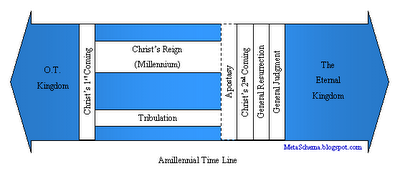 Preterists routinely assert that the Antichrist or “Beast” already appeared in the first century and that Revelation 13 and its associated texts have been fulfilled. For instance, Kenneth L. Gentry writes,
Preterists routinely assert that the Antichrist or “Beast” already appeared in the first century and that Revelation 13 and its associated texts have been fulfilled. For instance, Kenneth L. Gentry writes,
I understand the beast to portray the Roman empire (kingdom) generally and Emperor Nero Caesar (king) specifically. I do so for several reasons. (1) The events and characters of Revelation are in the time of John’s original audience (1:1, 3; 22:6, 10, 12). Interestingly, the beast arises from the sea (13:1), which reflects the geographical perspective of Rome when considered either from Patmos (from where John writes) or Israel (of which John writes).[1]
This fails on a number of levels the most flagrant being that most scholars date the book of Revelation to after the time of the events in question. GK Beale writes, “The consensus among twentieth-century scholars is that the Apocalypse was written during the reign of Domitian around 95 ad” [2] Furthermore, the ancient witness supports the later dating as well. Irenaeus placed the time of writing “almost in our day, towards the end of Domitian’s reign.”[3] The church historian Eusebius agreed with Irenaeus’ view.[4]
Also the apostle John, the author of the book of Revelation, in a letter written in the 90s predicts a future antichrist, “Παιδία, ἐσχάτη ὥρα ἐστίν, καὶ καθὼς ἠκούσατε ὅτι ἀντίχριστος ἔρχεται, καὶ νῦν ἀντίχριστοι πολλοὶ γεγόνασιν, ὅθεν γινώσκομεν ὅτι ἐσχάτη ὥρα ἐστίν.” (1 Jn 2:18) Here we see “antichrist” as a nominative singular juxtaposed against “antichrists” nominative plural. It also has a chiastic structure:
A. This is the last hour
B. Antichrist is coming
B´. Many antichrists have come
A´. This is the last hour.
The last hour began with the death and resurrection of Jesus Christ (cf. Heb. 1:2) and his second coming could occur at any time. But John is arguing in AD 90 that we know it’s the last hour because the “antichrist” (nominative singular) “is coming” – (ἔρχεται – present, middle/passive, indicative, 3rd person, singular). It is abundantly clear that writing well after the destruction of the temple, John means to say that although many false teachers or false messiahs have already appeared, he is still expecting the final one. Given he wrote the book of Revelation, I’ll take his word for it.
Moreover, John stated that he wrote the Apocalypse on the island of Patmos, and according to the church Father, Tertullian, John was banished from Rome to Patmos after being miraculously preserved from a plunge into boiling oil.[5] It is said that the entire Coliseum audience were converted to Christianity upon witnessing this miracle. This event was set during the reign of Domitian supporting the late date of John’s exile.
In fact, I just don’t see any preterists in the early church and shouldn’t they have been in a position to know? When you read their writings it is clear they did not believe that prophecies had been fulfilled. For instance, the Didache (The Teaching of the 12 Apostles) dated by most scholars to the late first or early 2nd century, still anticipates the events predicted by Jesus in the Olivet discourse to occur in the future:
16. Be watchful for your life; let your lamps not be quenched and your loins not ungirded, but be ye ready; for ye know not the hour in which our Lord cometh. 2And ye shall gather yourselves together frequently, seeking what is fitting for your souls; for the whole time of your faith shall not profit you, if ye be not perfected at the last season. 3For in the last days the false prophets and corrupters shall be multiplied, and the sheep shall be turned into wolves, and love shall be turned into hate. 4For as lawlessness increaseth, they shall hate one another and shall persecute and betray. And then the world-deceiver shall appear as a son of God; and shall work signs and wonders, and the earth shall be delivered into his hands; and he shall do unholy things, which have never been since the world began. 5Then all created mankind shall come to the fire of testing, and many shall be offended and perish; but they that endure in their faith shall be saved by the Curse Himself. 6And then shall the signs of the truth appear; first a sign of a rift in the heaven, then a sign of a voice of a trumpet, and thirdly a resurrection of the dead; 7yet not of all, but as it was said: The Lord shall come and all His saints with Him. 8Then shall the world see the Lord coming upon the clouds of heaven.[6]
The Didache was lost for centuries until a Greek manuscript was rediscovered in 1873 by Philotheos Bryennios, a Greek Orthodox Bishop. In this ancient manuscript, we see an overt reference to Mathew 24:12 and that future “world-deceiver shall appear as a son of God; and shall work signs and wonders, and the earth shall be delivered into his hands; and he shall do unholy things, which have never been since the world began.” The Apostolic fathers were not preterists. Neither were any of the apostles. Paul firmly connects the end time abomination of desolation and Antichrist to the temple:
“Let no one deceive you in any way. For that day will not come, unless the rebellion comes first, and the man of lawlessness is revealed, the son of destruction, who opposes and exalts himself against every so-called god or object of worship, so that he takes his seat in the temple of God, proclaiming himself to be God.” (2 Th 2:3–4)
This refers to a literal rebuilt temple because Paul’s readers in Thessalonica would have certainly understood the Jerusalem Temple. This end time event is also predicted in Daniel 9:27 and Daniel 12:11 and finds parallel in Revelation 13:5-8. The early church fathers and several modern scholars accept the literal view. This man is the Antichrist (1 John 2:18) and Paul connected his appearance to the time of Christ’s second coming, “And then the lawless one will be revealed, whom the Lord Jesus will kill with the breath of his mouth and bring to nothing by the appearance of his coming.” (2 Th 2:8) Jesus did not return in AD 70, so this is necessarily future. I wrote my exegetical research paper for my Masters on 2 Thessalonians 2, if you are interested in a in depth analysis, you can download it here.
If the preterist view is true, it seems John and Paul were wrong about the final Antichrist. The early Fathers Irenaeus, Tertullian and Eusebius and the majority of modern biblical scholars are all wrong about the dating or, even worse, the book of Revelation does not belong in the cannon because it’s a farce written after the fact. Either conclusion puts preterism on the fringe. Also, if preterism were true it seems like the early church would be celebrating the fulfillment of those prophecies not still expecting them to come to pass. These are just a few more reasons for why preterism seems so absurd to me.
[1]Kenneth L. Gentry, Jr., “A Preterist View of Revelation” In , in Four Views on the Book of Revelation, ed. Stanley N. Gundry and C. Marvin Pate, Zondervan Counterpoints Collection (Grand Rapids, MI: Zondervan, 1998), 68.
[2]G. K. Beale, The Book of Revelation : A Commentary on the Greek Text (Grand Rapids, Mich.; Carlisle, Cumbria: W.B. Eerdmans; Paternoster Press, 1999), 4.
[3] Irenaeus, Against Heresies 5.30.3.
[4] Eusebius, Church History 3.18.3.
[5] Tertullian, The Prescription of Heretics, ch. 36; http://www.newadvent.org/fathers/0311.htm (accessed 7/7/2012).
[6] Joseph Barber Lightfoot and J. R. Harmer, The Apostolic Fathers (London: Macmillan and Co., 1891), 235.




